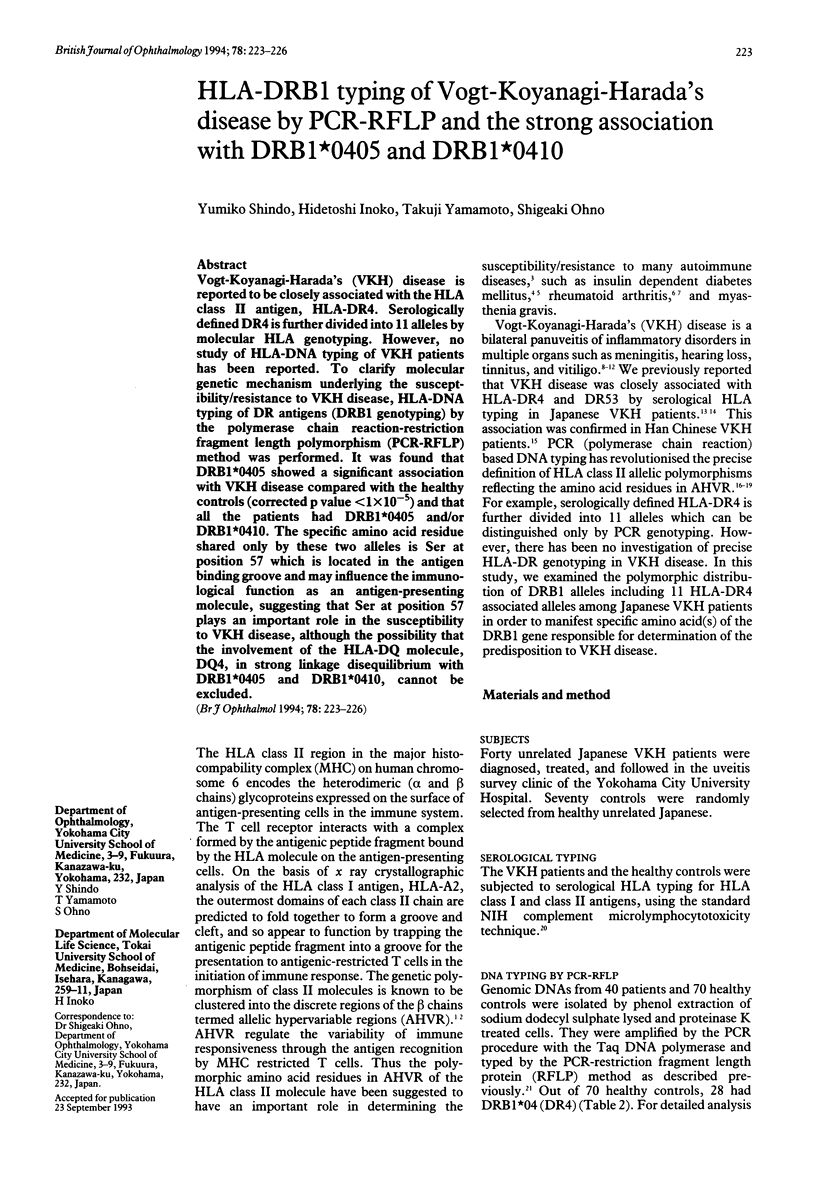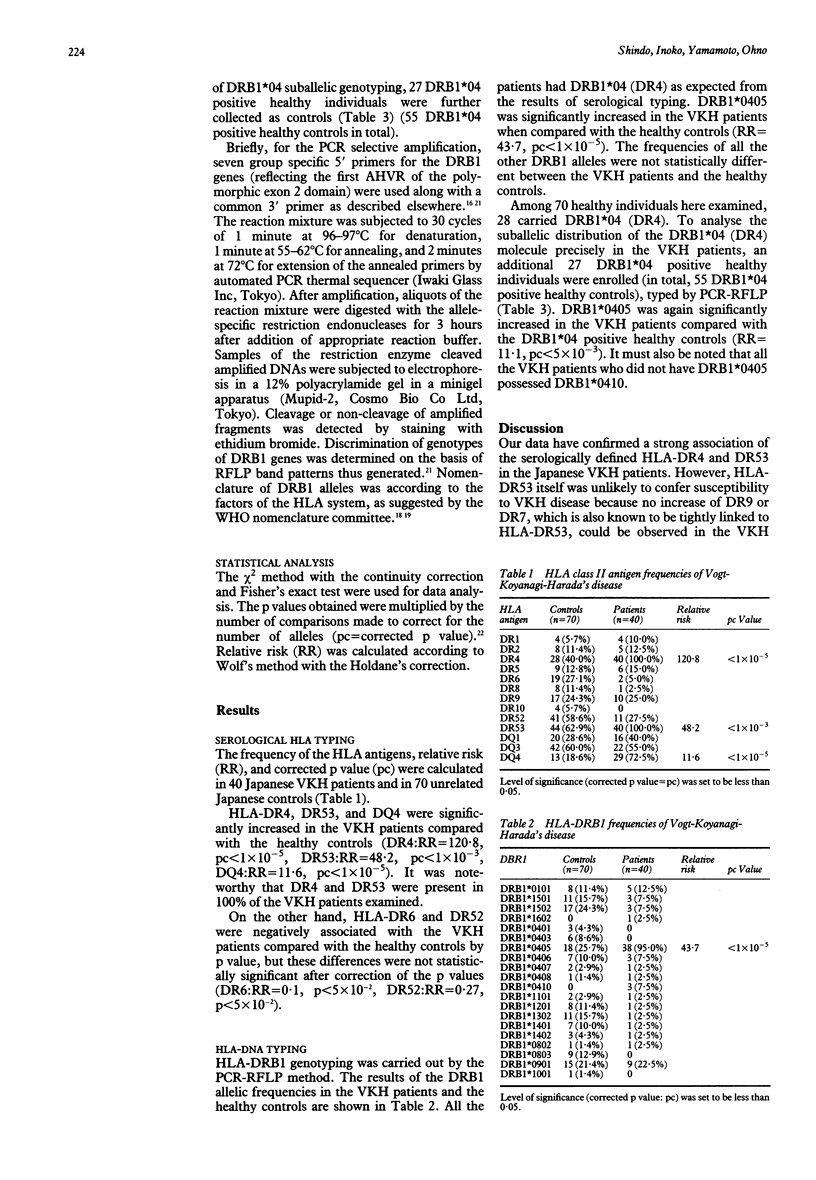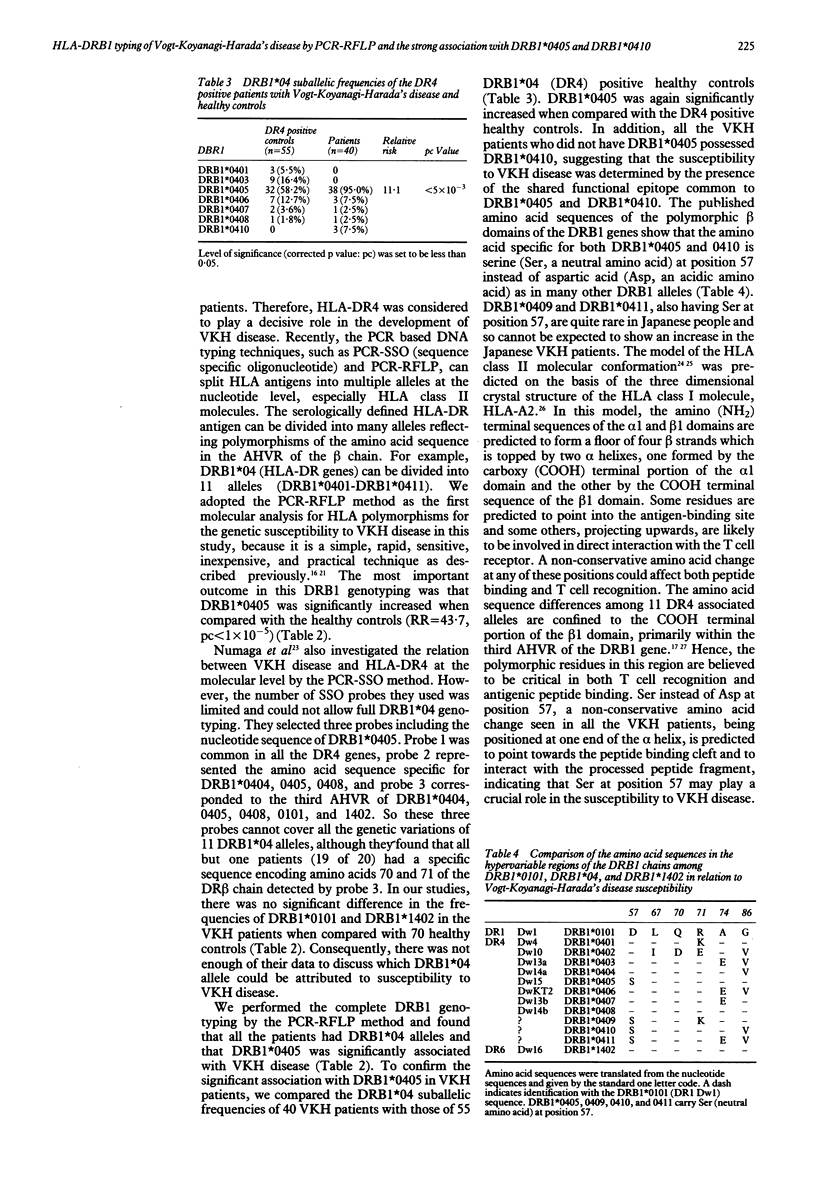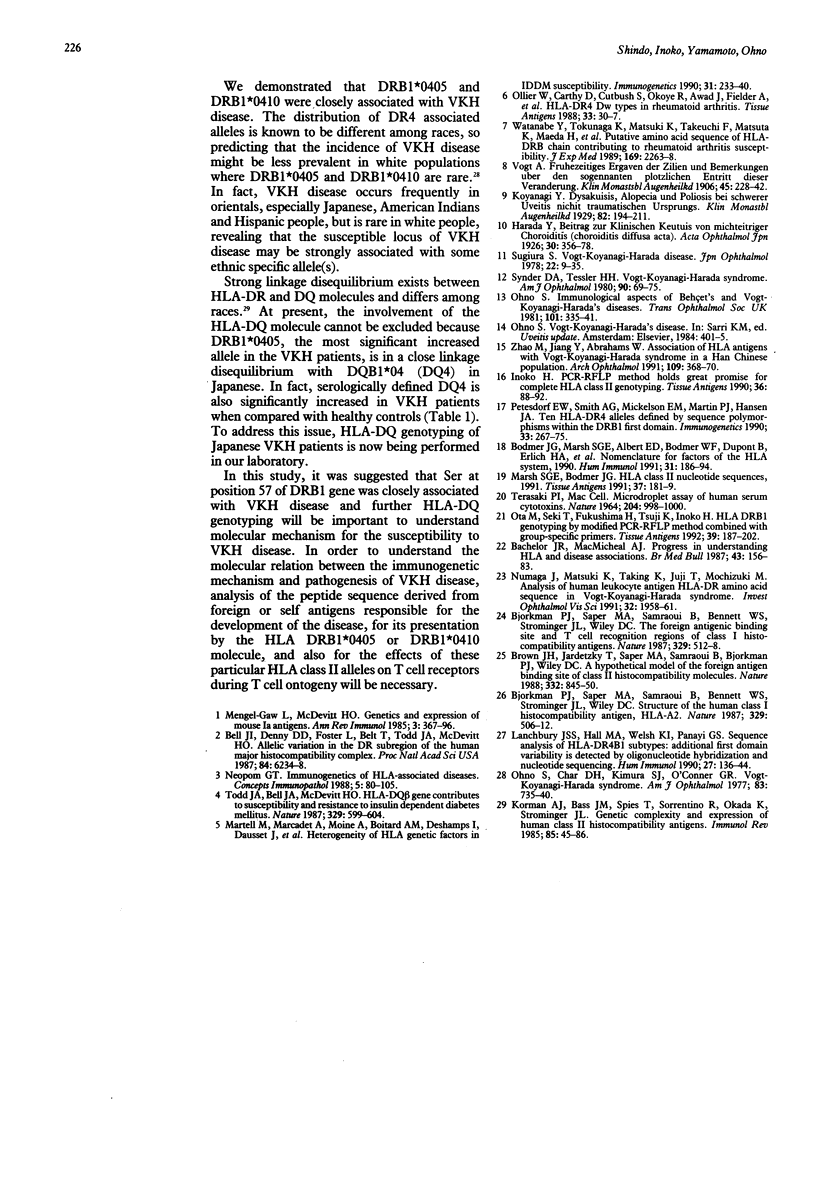Abstract
Vogt-Koyanagi-Harada's (VKH) disease is reported to be closely associated with the HLA class II antigen, HLA-DR4. Serologically defined DR4 is further divided into 11 alleles by molecular HLA genotyping. However, no study of HLA-DNA typing of VKH patients has been reported. To clarify molecular genetic mechanism underlying the susceptibility/resistance to VKH disease, HLA-DNA typing of DR antigens (DRB1 genotyping) by the polymerase chain reaction-restriction fragment length polymorphism (PCR-RFLP) method was performed. It was found that DRB1*0405 showed a significant association with VKH disease compared with the healthy controls (corrected p value < 1 x 10(-5)) and that all the patients had DRB1*0405 and/or DRB1*0410. The specific amino acid residue shared only by these two alleles is Ser at position 57 which is located in the antigen binding groove and may influence the immunological function as an antigen-presenting molecule, suggesting that Ser at position 57 plays an important role in the susceptibility to VKH disease, although the possibility that the involvement of the HLA-DQ molecule, DQ4, in strong linkage disequilibrium with DRB1*0405 and DRB1*0410, cannot be excluded.
Full text
PDF



Selected References
These references are in PubMed. This may not be the complete list of references from this article.
- Batchelor J. R., McMichael A. J. Progress in understanding HLA and disease associations. Br Med Bull. 1987 Jan;43(1):156–183. doi: 10.1093/oxfordjournals.bmb.a072169. [DOI] [PubMed] [Google Scholar]
- Bell J. I., Denney D., Jr, Foster L., Belt T., Todd J. A., McDevitt H. O. Allelic variation in the DR subregion of the human major histocompatibility complex. Proc Natl Acad Sci U S A. 1987 Sep;84(17):6234–6238. doi: 10.1073/pnas.84.17.6234. [DOI] [PMC free article] [PubMed] [Google Scholar]
- Bjorkman P. J., Saper M. A., Samraoui B., Bennett W. S., Strominger J. L., Wiley D. C. Structure of the human class I histocompatibility antigen, HLA-A2. Nature. 1987 Oct 8;329(6139):506–512. doi: 10.1038/329506a0. [DOI] [PubMed] [Google Scholar]
- Bjorkman P. J., Saper M. A., Samraoui B., Bennett W. S., Strominger J. L., Wiley D. C. The foreign antigen binding site and T cell recognition regions of class I histocompatibility antigens. Nature. 1987 Oct 8;329(6139):512–518. doi: 10.1038/329512a0. [DOI] [PubMed] [Google Scholar]
- Bodmer J. G., Marsh S. G., Albert E. D., Bodmer W. F., Dupont B., Erlich H. A., Mach B., Mayr W. R., Parham P., Sasazuki T. Nomenclature for factors of the HLA system, 1990. Hum Immunol. 1991 Jul;31(3):186–194. doi: 10.1016/0198-8859(91)90025-5. [DOI] [PubMed] [Google Scholar]
- Brown J. H., Jardetzky T., Saper M. A., Samraoui B., Bjorkman P. J., Wiley D. C. A hypothetical model of the foreign antigen binding site of class II histocompatibility molecules. Nature. 1988 Apr 28;332(6167):845–850. doi: 10.1038/332845a0. [DOI] [PubMed] [Google Scholar]
- Inoko H. PCR-RFLP method holds great promise for complete HLA class II genotyping. Tissue Antigens. 1990 Aug;36(2):88–92. doi: 10.1111/j.1399-0039.1990.tb01806.x. [DOI] [PubMed] [Google Scholar]
- Korman A. J., Boss J. M., Spies T., Sorrentino R., Okada K., Strominger J. L. Genetic complexity and expression of human class II histocompatibility antigens. Immunol Rev. 1985 Jul;85:45–86. doi: 10.1111/j.1600-065x.1985.tb01130.x. [DOI] [PubMed] [Google Scholar]
- Lanchbury J. S., Hall M. A., Welsh K. I., Panayi G. S. Sequence analysis of HLA-DR4B1 subtypes: additional first domain variability is detected by oligonucleotide hybridization and nucleotide sequencing. Hum Immunol. 1990 Feb;27(2):136–144. doi: 10.1016/0198-8859(90)90110-b. [DOI] [PubMed] [Google Scholar]
- Marsh S. G., Bodmer J. G. HLA class II nucleotide sequences, 1991. Tissue Antigens. 1991 Apr;37(4):181–189. doi: 10.1111/j.1399-0039.1991.tb01870.x. [DOI] [PubMed] [Google Scholar]
- Martell M., Marcadet A., Moine A., Boitard C., Deschamps I., Dausset J., Bach J. F., Cohen D. Heterogeneity of HLA genetic factors in IDDM susceptibility. Immunogenetics. 1990;31(4):233–240. doi: 10.1007/BF00204893. [DOI] [PubMed] [Google Scholar]
- Mengle-Gaw L., McDevitt H. O. Genetics and expression of mouse Ia antigens. Annu Rev Immunol. 1985;3:367–396. doi: 10.1146/annurev.iy.03.040185.002055. [DOI] [PubMed] [Google Scholar]
- Nepom G. T. Immunogenetics of HLA-associated diseases. Concepts Immunopathol. 1988;5:80–105. [PubMed] [Google Scholar]
- Numaga J., Matsuki K., Tokunaga K., Juji T., Mochizuki M. Analysis of human leukocyte antigen HLA-DR beta amino acid sequence in Vogt-Koyanagi-Harada syndrome. Invest Ophthalmol Vis Sci. 1991 Jun;32(7):1958–1961. [PubMed] [Google Scholar]
- Ohno S., Char D. H., Kimura S. J., O'Connor G. R. Vogt-Koyanagi-Harada syndrome. Am J Ophthalmol. 1977 May;83(5):735–740. doi: 10.1016/0002-9394(77)90142-8. [DOI] [PubMed] [Google Scholar]
- Ohno S. Immunological aspects of Behçet's and Vogt-Koyanagi-Harada's diseases. Trans Ophthalmol Soc U K. 1981 Sep;101(3):335–341. [PubMed] [Google Scholar]
- Ollier W., Carthy D., Cutbush S., Okoye R., Awad J., Fielder A., Silman A., Festenstein H. HLA-DR4 associated Dw types in rheumatoid arthritis. Tissue Antigens. 1989 Jan;33(1):30–37. doi: 10.1111/j.1399-0039.1989.tb01674.x. [DOI] [PubMed] [Google Scholar]
- Ota M., Seki T., Fukushima H., Tsuji K., Inoko H. HLA-DRB1 genotyping by modified PCR-RFLP method combined with group-specific primers. Tissue Antigens. 1992 Apr;39(4):187–202. doi: 10.1111/j.1399-0039.1992.tb01935.x. [DOI] [PubMed] [Google Scholar]
- Petersdorf E. W., Smith A. G., Mickelson E. M., Martin P. J., Hansen J. A. Ten HLA-DR4 alleles defined by sequence polymorphisms within the DRB1 first domain. Immunogenetics. 1991;33(4):267–275. doi: 10.1007/BF00230505. [DOI] [PubMed] [Google Scholar]
- Snyder D. A., Tessler H. H. Vogt-Koyanagi-Harada syndrome. Am J Ophthalmol. 1980 Jul;90(1):69–75. [PubMed] [Google Scholar]
- TERASAKI P. I., MCCLELLAND J. D. MICRODROPLET ASSAY OF HUMAN SERUM CYTOTOXINS. Nature. 1964 Dec 5;204:998–1000. doi: 10.1038/204998b0. [DOI] [PubMed] [Google Scholar]
- Todd J. A., Bell J. I., McDevitt H. O. HLA-DQ beta gene contributes to susceptibility and resistance to insulin-dependent diabetes mellitus. Nature. 1987 Oct 15;329(6140):599–604. doi: 10.1038/329599a0. [DOI] [PubMed] [Google Scholar]
- Watanabe Y., Tokunaga K., Matsuki K., Takeuchi F., Matsuta K., Maeda H., Omoto K., Juji T. Putative amino acid sequence of HLA-DRB chain contributing to rheumatoid arthritis susceptibility. J Exp Med. 1989 Jun 1;169(6):2263–2268. doi: 10.1084/jem.169.6.2263. [DOI] [PMC free article] [PubMed] [Google Scholar]
- Zhao M., Jiang Y., Abrahams I. W. Association of HLA antigens with Vogt-Koyanagi-Harada syndrome in a Han Chinese population. Arch Ophthalmol. 1991 Mar;109(3):368–370. doi: 10.1001/archopht.1991.01080030070041. [DOI] [PubMed] [Google Scholar]


